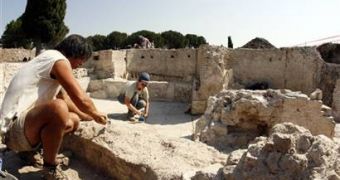Romans really knew how to live large. But this goes beyond any expectation: archaeologists have partially dug up a 2nd-century bath complex, part of the vast, luxurious residence of a wealthy Roman and this exceeds previous findings. Ancient Romans were passionate bathing-lovers, turning baths and bathing into an art and ritual. They had communal bath houses, made of a series of chambers of alternating temperatures, with hot and cold baths.
The two-story building extended over at least 5 acres (20,000 square meters) and compassed exceptionally well-preserved decorated hot rooms, vaults, changing rooms, marble latrines and an underground chamber where slaves fueled the fire to warm the water in the baths. There was an ancient heating system, made of pipes that headed hot air throughout the villa.
"Statues and water cascades decorated the interiors," American archaeologist Darius A. Arya, the head of the excavation and professor at the American Institute for Roman Culture, told The Associated Press on Thursday. But only pedestals and fragments of that have been recovered.
Roman bathing was a social event, a moment of relaxation but also a method to get rid of toxins.
"The Romans had more leisure time than other people, and it's here in the baths that they typically spent their time. Because you could eat well, you could get a massage, you could have sex, you could gossip, you could play your games, you could talk about politics - you could spend the whole day here. However, to have a bath complex of this size, this scale, it's very unusual," explained Arya.
"The complex is believed to be part of a multiple-story villa that belonged to the Roman equivalent of a billionaire of today, a man called Quintus Servilius Pudens who was friends with Emperor Hadrian," he added.
It is not known whether the baths were open to the public or reserved just for the amuzament of the guests of Pudens.
"These people lived a magnificent existence and were able to provide entertainment to others. Excavations at the Villa delle Vignacce park lasted a total of 10 weeks, and it is planned to continue," said Arya.

 14 DAY TRIAL //
14 DAY TRIAL //